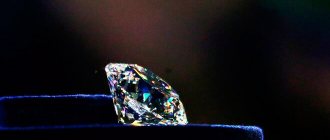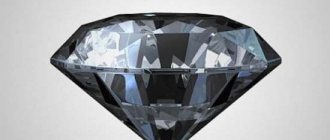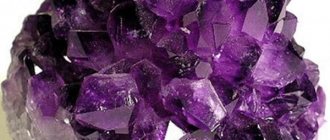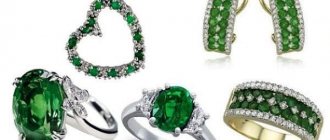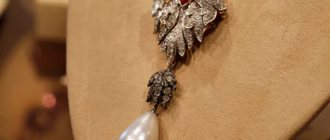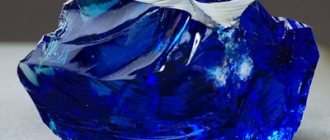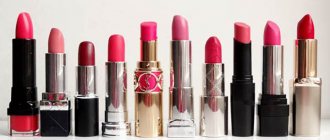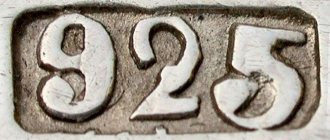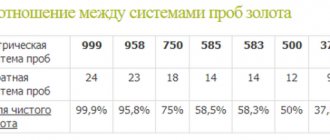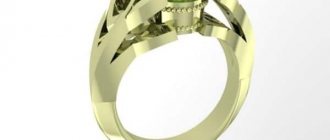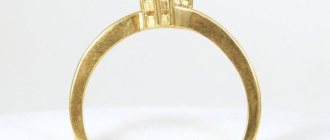Red ruby: name and history
The name comes from the Latin word “rubeus” - “red”. The ancient name of ruby is noble red corundum, lala, manikiya, ratnanayana. It is believed that the stone became known in Europe in the 4th century. BC, when the campaigns of Alexander the Great took place. Meanwhile, it is likely that under the guise of carbuncles the stone was known even in earlier times, brought from Africa. The gem was highly valued in the East and India. Of course, only the highest nobility could afford jewelry with rubies. Since then it has been considered a “royal” stone. In India and Burma, it has been considered a talisman and amulet since ancient times.
Burmese is the most expensive ruby in the world
How much is a ruby worth? The most expensive is the Sunrise ruby, which was sold in 2015 at Sotheby’s for $30.3 million. It was found in Burma, weighs 25.59 carats and is pigeon's blood in color.
Yakhont worm-shaped is the ancient name for ruby in Rus' (and Yakhont azure is a sapphire).
Rubin Elizabeth Taylor
You can mention Elizabeth Taylor in every article about jewelry. The actress loved jewelry, understood it, knew how to wear it... and collected one of the most amazing collections. The star of her collection was a ruby ring weighing more than 8 carats, created by the masters of the Van Cleef & Arpels jewelry house and given to the actress by Richard Burton as a Christmas surprise in 1968. By the way, once at the auction, the ring did not go unnoticed. The gavel came down three times on the $4.2 million offer.
Place of Birth
Burma (Myanmar) is famous for the extraction of the highest quality minerals, transparent, without defects and with a purple tint, which are highly valued in the jewelry world. The deposits were developed already in the Bronze Age.
Sri Lanka, Thailand, Afghanistan, Russia, Tanzania and Kenya also mine minerals. The same deposit can produce crystals of significantly different quality.
Ruby mining Sri Lanka
Gems mined in Tanzania are distinguished by their rare crimson color, transparency and absence of defects. And although they are not large in this deposit (the largest stone is 2.5 carats), their rare color has earned them fame throughout the world. Thai gems have a dark red, brownish tint. A special feature of mining in Thailand is their open mining method - at a depth of 8 meters or at the bottom of the river. In Russia, a famous mining site is the Polar Urals. The gems are quite large, up to 15 cm, have a deep purple-red color, can be transparent and exhibit star-shaped asterism. Their value is much lower than Burmese minerals due to the developed isolation and the presence of inclusions.
Gem prices in the world
In world practice, there are organizations that produce guide tables with the value of rubies. For example, in one of the magazines the following classification is given:
- A low quality ruby will cost, depending on its origin, from $75 to $3,500 per carat. The most expensive are Burmese, the cheapest are heated.
- Good quality rubies originating from Burma will be valued at 5-12 thousand, from Mozambique - 2-8 thousand, processed - 1.5-4 thousand.
- A very good quality ruby is much more expensive. Treated stones from this category will have a price of 5–9 thousand, and untreated stones from Burma will cost 16–40 thousand.
- Ruby of excellent quality: heated 12-23 thousand, Mozambique - 20-30 thousand, Burma - 40-70 thousand.
- Rubies weighing more than 4 carats will be more expensive. For example, such specimens from Burma will be valued at 60–90 thousand per carat.
The price of a ruby directly depends on its beauty, color, purity and the absence of visible defects
Ruby - magical properties
“Dragon blood clot,” as ancient magicians believed, has an irresistible effect on people, thereby making its owner powerful and powerful.
Favorite gem of Ivan the Terrible. Monomakh's hat is decorated with rubies and emeralds.
Fire element stone. Modern astrologers believe that the mineral gives clarity to the mind, strengthens the heart, and gives courage and bravery. It is one of the most revered stones in India, where it symbolizes the Sun. There it was believed that, along with power, the stone bestows generosity and compassion. In the East, it is a symbol of vital energy, health and passionate love (pink stone - tender love). Undoubtedly, the stone has magical properties.
- For power – gives energy and strength.
- A powerful amulet - protection from evil energy, envy, and danger. (Recommended for people in “dangerous” professions: rescuers, military, etc.).
- Protects against poisoning - it is believed that the mineral loses its shine or transparency if it comes into contact with poison (poisoned drink or food). One of the reasons for its popularity among the reigning people, who were afraid of poisoning.
- Love. It is believed that if you give a gem to a girl, she will awaken reciprocal feelings. It is also believed to make women fertile.
- Energy. Ruby not only bestows strength and power, but also strengthens the health of its owner, enhances his vital energy, gives joy and prolongs life.
People with negative energy, that is, those who have wicked thoughts and goals, should not wear a gemstone. It can harm them because it only reinforces negative traits such as hatred and greed.
History and origin
Man's acquaintance with ruby took place back in the Bronze Age .
It was first mined in Burma, then deposits were discovered in India, Ancient Rome and Greece. One of the Indian legends says that the mineral turned red after being tempered in the blood of the demon Vala. The sun god Surya dropped the blood into the Bhakarta River, and its waves brought frozen red drops to the shores in the form of beautiful minerals. Interesting! The ancient name of the stone is “lal”; later it received two more names: carbuncle and yakhont.
Ruby stone - healing properties
In ancient India, the mineral was used in the treatment of epilepsy, paralysis and depression. In Europe in the Middle Ages, a powder was made from it, which was “prescribed” to rich patients to treat the gastrointestinal tract (the powder should be drunk by dissolving the powder in wine), as well as impotence. In modern lithotherapy, the mineral plays a large role in the treatment of diseases such as hypertension, bronchial asthma, diseases of the eyes, throat, ears, joints and spine. Helps get rid of insomnia and depression.
Healing properties are not only manifested when wearing jewelry with a gem, but also when drinking a water infusion (the larger the size of the stone, the more healing the infusion - ancient healers believed). Needless to say, synthetic ruby cannot have healing properties.
Ruby crystal for zodiac signs
Astrologers recommend wearing rubies to Aries, Leo and Sagittarius. You can wear the mineral with caution for Virgos and Taurus. They almost categorically insist on the danger of the gem for Cancers and Scorpios. Some modern astrologers believe that for Cancers this stone is suitable for strengthening love, as well as showing determination in achieving their goals. For Sagittarius, the mineral helps smooth out negative traits and solve important life problems. According to the horoscope, representatives of Libra, Aquarius and Cancer should be very careful when using the mineral as a talisman or amulet. If they are overly sensitive, they may not be able to cope with the energy of the stone.
Who is suitable according to their zodiac sign?
There is no need to talk long about who the gem is suitable for in the zodiac circle: ruby will help everyone. Interaction with the elements of signs looks like this:
- Fire ( Sagittarius, Aries, Leo ) – energy replenishment, restoration of vitality and good spirits.
- Water ( Pisces, Cancer, Scorpio ) – gives composure to thoughts and actions, harmonizes character, softens manifestations of conceit.
- Air ( Aquarius, Gemini, Libra ) – eliminates uncertainty in decisions and actions. Teaches self-control and adds self-confidence.
- Earth ( Capricorn, Taurus, Virgo ) – strengthens the spirit, promotes the development of rational thinking.
Artificial ruby
In the gemstone market, it is customary to “ennoble” rubies. Impurities are removed from the mineral, thus making it more transparent, and defects (cracks and voids) are filled with glass. An artificial analogue of a gem becomes more attractive in appearance and inexpensive compared to a natural one. Another way is to grow the mineral artificially. Only a specialist can distinguish artificial from natural minerals.
Also, scammers can use a less expensive one that is similar in appearance as a gemstone. Usually these are garnet and ruby. For technical purposes, artificial ruby is widely used, since it has the property of not entering into chemical reactions. For example, in dentistry - as a material for implantation and prosthetics.
Features of ruby and its varieties
Natural ruby has many shades - from rich red to light lilac - the color of the stone depends on its place of origin. Of particular value are stones with a pronounced fluorescent quality: at a certain angle of incidence of light, a ruby seems to flicker, and most often such specimens are found in the territory of Burma (now Myanmar). But only an experienced gemologist will determine the origin of the stone, since the jewelry market is replete with refined rubies. For modern stones, this condition is considered acceptable, and in mass production, approximately 95% of rings with rubies up to 1 carat are decorated with filled, ennobled stones. Post-processing changes the initially unsightly appearance of the raw material to the presentability familiar to everyone.
| Natural quality | After cutting | After filling and warming up |
There are only a few thousand untreated, high-quality rubies in the whole world and almost all of them are in private collections, in the arsenal of fashion jewelry houses. The price of high quality rough rubies can be compared with the cost of diamonds of the same weight and cut. Very expensive.
The most important deposits of rubies are Burma (aka Myanmar, the deposits are almost depleted), Tanzania, and Madagascar. Large volumes and average quality of stones are found in India, Thailand and Vietnam.
| Palette of ruby shades |
Indian pink ruby
Such a stone is an infrequent find, since a ruby that has shades of pink is a very young corundum with a small content of chromium impurities, which ultimately determines the color. Pink ruby, as a rule, is of medium quality, mined in India, and has a heterogeneous structure: if you look at the stone through a magnifying glass, you can see cracks inside, “curtains.” Inexpensive, but in rings, rubies of this shade look very cute, gentle, and romantic.
Thailand ruby
As in India, there are also small deposits of pink and similar rubies, but the variety of colors extends to rich brown tones. The color is often mixed with purple highlights, which are quite valuable in the jewelry world. And if it were not for the natural quality of rubies, which cannot be called worthy without filling and heat treatment, these beautiful stones would definitely change the existing hierarchy of rubies. In addition to light ones, rich cherry corundums are quite popular among the local population; they have little authority in European countries.
| raw ruby, Thailand |
Vietnamese ruby
These stones are the closest relatives of Thai rubies. It is difficult to call the quality of local corundums unique, but lovers of inexpensive precious stones should be careful: processed Vietnamese rubies sometimes pass off as valuable pink sapphires. Finding a high quality Vietnamese ruby is a great success.
Burmese ruby
If we compare this quality with other stones, then magnificent Kashmir sapphires can be considered equal to Burmese rubies - rare, of magnificent beauty and incomprehensible value. Every jeweler dreams of holding a real Burmese ruby of a couple of carats in his hands; the names Mogog and Mong Htsu are familiar to all masters, without exception.
Recognizable from thousands, the pure red color, known as “pigeon blood”, the rare purity of stones and the unique silk “glow” are determined by professionals in the jewelry world with extreme care. Not every Burmese ruby is pigeon's blood, but every stone of this color is guaranteed to be Burmese. Beauty without unnecessary words, even in unrefined stones: the best is the enemy of the good.
| Crimson Flame, $18.38 million. | Graff Ruby, $8.6 million. | Patiño ruby ring, $6,736,750 |
| 15.04 carats | 8.62 carats | 32.08 carats |
Of course, rings with rubies of this quality are only an item for auction. And if you want to purchase jewelry with a “pigeon blood” stone and pure Burmese origin, you will have to pay a considerable amount even for replicated rings with small rubies.
| Ruby "Pigeon's Blood" | Ring with ruby "Pigeon blood" | Burmese ruby |
| good quality, 1.22 carats | average characteristics, 2.02 carats | regular, 2.88 carats |
| US$11,000 | US$9022 | US$900 |
Tanzanian ruby
Blood red is the name these African rubies are known by. Despite this characteristic, the stones will captivate with their beautiful, deep shades, closer to garnet color. Dark rubies look solid, juicy, and are used more often in evening jewelry - rings for events, celebrations, important dates. The purest Tanzanian rubies come from the Songea deposit, and in this case the size directly affects the beauty of the stone: small ones have a more revealing fluorescence, a soft matte glow and look impressive even without treatment.
| Raw |
| Tanzanian ruby |
Madagascar rubies
Since the Burmese deposits have almost exhausted their resources, and it is almost impossible to find a ruby larger than 3 carats in Myanmar, the jewelry world is actively exploiting the deposits of Madagascar. Of course, they should not be compared with the quality of Burmese ones, but still, rubies from Madagascar deposits have a certain charm. They are characterized by a rather dense color from red to shades of purple, a beautiful glow and some velvety.
Another feature of Madagascar rubies is the generous presence of natural inclusions: cracks, air, and other signs of natural origin: nature has nothing ideal. But the same filling technology significantly transforms the appearance of the stone. Of course, there are quite good natural specimens for which the correct cut is enough (photo in the middle), but refining technologies are increasingly taking their toll.
| Natural look | Heated ruby | Rubies with heating and filling |
How to distinguish a ruby from a fake
Both synthetic and other stones are similar to natural ruby: spinel, garnet, tourmaline. Most often, scammers can sell garnets under the guise of a ruby. A large natural ruby is a very rare phenomenon and its cost will be very high. By the obvious discrepancy between price and size, one can distinguish between synthetic and natural stone. How to distinguish a natural ruby? It can be distinguished from pyrope, a type of garnet that is most often passed off as a ruby, by its dichroism property. This phenomenon can be seen using a dichroscope (a special magnifying glass through which color changes from dark to light can be seen in layers). Dichroism is characteristic only of rubies.
Property of dichroism
Unfortunately, it is not possible to distinguish natural from artificial at home; this can only be done by a specialist using special tools.
The most precious stones
Record: The only diamond to receive the highest grade from the American Gem Society (AGS) - 0/0/0
Crater of Diamonds State Park is located in Pike County, Arkansas, USA. In 1990, the most miraculous discovery ever made in this park was made - Shirley Strawn found the Strawn-Wagner Diamond. The diamond originally weighed 3.09 carats (620 milligrams), but after it was cut to size 1.09 carats (220 milligrams), it was given the highest grade by the American Gem Society (AGS) of the Gemological Institute of America - 0/0/0, which indicates that there are no flaws in the cut, color or clarity of the stone. This was the first time in history that a diamond received the highest grade from the American Gem Society. According to the laboratory director of the American Gem Society, Peter Yantzer, this diamond is one of the rarest in the world, and the chance of finding it was only one in a billion.
Record: The largest and most valuable opal in the world
The largest and most valuable opal in the world was found in 1956, in the Eight-Mile opal field, in the mining town of Coober Pedy, in southern Australia. It was discovered at a depth of 9,144 meters and was named the Australian Olympic Opal due to the Olympic Games taking place in Melbourne at the time. It weighs an astounding 17,000 carats (3450 grams) and is 99% gem quality.
In 2005, the price of an Australian Olympic opal was A$2.5 million. Due to the purity of the gemstone, approximately 7,000 carats could have been cut from it, but because the stone is so unique, it will be left in its original organic form.
Record: Most expensive gemstone ever sold at auction
Some of the most highly valued gemstones in the world are colored diamonds that have been given a grade (D) and are free of imperfections. One such diamond was discovered in the 1950s when American jeweler Harry Winston bought a rare pink diamond from an unknown collector. The diamond size was 24.78 carats. Winston described it as "one of the greatest diamonds ever discovered." It has been classified by the Gemological Institute of America as a "fantastic deep pink diamond", which in itself is a very high color rating. This gemstone has also been graded as a Type IIa diamond, placing it in the top 2% of diamonds in the world. It was given a rectangular shape with rounded edges and was inlaid into a ring.
In 1950, Winston sold the diamond to a private collector, who owned it until 2010. At the time, it was offered for sale by Sotheby's in Geneva, Switzerland, where the pink diamond was sold for US$46 million, making it the most expensive single gemstone ever sold at auction.
Record: Largest processed yellow topaz in the world
The American Golden Topaz currently holds the record as the largest processed yellow topaz in the world. Moreover, it is one of the largest faceted gemstones of any kind. Its size is 22892 carats (4.5785 kilograms). It has 172 facets (flat cuts that are made on gemstones to help them reflect light). This gem was cut from a piece of yellow topaz that weighed 11.8 kilograms. The rough stone was discovered in the Brazilian state of Minas Gerais. Leon Agee spent two years processing it. In 1988, the American Golden Topaz was donated to the Smithsonian Institution and put on display at the National Museum of Natural History in Washington, DC. The price of this gem remains unknown.
Record: Largest cut blue sapphire in the world.
In 1907, a remarkable huge blue sapphire was discovered near the summit of Adams Peak, Sri Lanka. This was an incredible event, as blue is one of the rarest sapphire colors on the planet. The sapphire was subsequently processed and polished into the Blue Giant of the East. According to those years, the sapphire weighed 466 carats, and accordingly became the largest cut blue sapphire in the world. The Blue Giant of the East is a cushion-cut sapphire with a deep and rich blue color. Under ultraviolet light, this gemstone emits a strong orange-red glow. In 1907, the sapphire was valued at £7,000. It was sold to an anonymous American collector, and its whereabouts remained unknown until 2004, when a huge blue sapphire appeared at the Magnificent Jewels Christie auction, which was held on May 19, 2004 in Geneva, Switzerland. The stone was not advertised as the Blue Giant of the East, but the size, cut and color were similar, so everyone assumed it was it. The gem sold at that auction weighed 486.52 carats, making it the largest cut quality sapphire ever sold at auction.
Surprisingly, the Blue Giant of the East did not sell, but was subsequently purchased by an anonymous buyer for the incredible sum of $1 million. Its sale was shrouded in mystery due to the secrecy and connection of the stone with the Blue Giant of the East.
Record: Largest missing diamond in the world
In 1888, the De Beers Diamond was discovered in the Kimberley mines in South Africa. It was one of the largest diamonds ever found and weighed 428 carats. After the diamond was processed, it turned into a magnificent gemstone weighing 234.65 carats. This is a pale yellow cushion-cut diamond of unknown clarity.
The De Beers Diamond is currently the eighth largest cut diamond in the world. In 1928, this diamond became the main decoration of the Patiala Necklace, which was created by the House of Cartier especially for the Maharaja of Patiala (Bhupinder Singh of Patiala). This necklace is one of the most expensive pieces of jewelry ever made. It was encrusted with 2,930 diamonds, including the De Beers diamond, weighing 234.65 carats. The total weight of the Patiala Necklace was approximately 962.25 carats.
In 1948, the necklace disappeared. According to some reports, the De Beers Diamond was put up for auction at Sotheby's in Geneva on May 6, 1982, and a bid of $3.6 million was made, but the amount did not reach the asking price, and the diamond was not sold. In 1998, part of the Patiala Necklace was discovered in London, in a second-hand jewelry store. However, all the large stones were missing, including the De Beers Diamond. To date, the De Beers Diamond remains the largest missing diamond.
Record: Largest faceted alexandrite in the world
A Smithsonian mixed cushion cut Alexandrite was discovered in Sri Lanka. Like most alexandrites, the Smithsonian Alexandrite is a red-green color stone that weighs 65.08 carats. It is now considered one of the rarest and most valuable gemstones in the world.
However, its status as the largest alexandrite in the world is the subject of much debate. In 2011, an alexandrite gemstone called Naleem Alexandrite was noted to weigh over 112 carats, but this was never confirmed. There have also been reports in the press that a private collector from Japan is in the possession of an alexandrite weighing 141.92 carats, which was certified by the State Gem Corporation. Almost nothing is known about this gemstone, but it is listed as the largest processed alexandrite on the Guinness World Records website. Alexandrite, which weighs 141.92 carats, would be worth over one hundred million US dollars.
Record: Largest ever cut, faceted diamond
In 1985, a worker at the Premier mine in South Africa discovered a large brown diamond measuring 755.5 carats (151 grams). It was one of the largest diamonds ever discovered, however, it was initially considered something of an ugly duckling. He even had a nickname - “Unnamed Brown”. The diamond was processed for two years in an underground room specially created to ensure that there were no vibrations. When this gemstone was finished, it weighed 545.67 carats (109.13 grams), making it the largest cut diamond in the world.
After the stone was processed, it turned into a beautiful yellow-brown diamond. In 1994, this diamond was exhibited in Thailand and was purchased by a group of Thai investors led by Henry Ho. The Golden Jubilee Diamond is currently housed in the Royal Thai Palace and is part of the Crown Jewels. According to some estimates, its value ranges between four and twelve million US dollars.
Record: The largest ruby with a double 12-pointed star in the world
Some rubies have a twelve-rayed asterism, or “star,” on the surface. This is quite a rare occurrence, so when a gemstone has an asterism on its surface, it becomes much more valuable than a regular one. A ruby with two stars is one in which the asterism is visible on both sides, which makes it even more expensive and valuable.
The largest double 12-pointed star ruby in the world is the Niilanjali Ruby, which weighs 1,370 carats (274 grams). It was discovered to the world at the end of 1988 and immediately entered the Guinness Book of Records as the largest ruby with a double star. This ruby is currently in the possession of Indian lawyer G Vidyaraj. When the ruby was inherited by a lawyer, it was covered in dirt and grime because people thought it carried a curse. No one dared to touch the precious stone for fear of desecration. The stone remained hidden for centuries until Vidyaraj finally cleaned and polished it, revealing its true beauty. Now he claims that he got the gem from the kings of the Vijayanagar Empire, of whom he is a direct descendant.
The exact cut, color and clarity of a ruby are not known. No one even has a photo of it (at this point a photo of another double star ruby was used to give a general idea of what this stone should actually look like). Due to the rarity of double star rubies, this gemstone is valued at approximately one hundred million US dollars.
Record: Largest single piece of emerald ever discovered
The largest piece of emerald ever found to date is the Bahia Emerald, which consists of a huge number of cylindrical emerald crystals embedded in rock, weighing a total of 1.9 million carats. The Bahia Emerald was recently valued at nine hundred million US dollars, which if sold would make it the most valuable gemstone in the world. However, according to most experts, its price is four hundred million US dollars.
It was originally discovered on July 9, 2001, in beryl mines in the western state of Bahia, Brazil. After being smuggled into the United States, the Bahia Emerald eventually ended up in New Orleans. After Hurricane Katrina, the Bahia Emerald spent two months submerged in nearly five meters of water before it was recovered. Then a huge block of emeralds was stolen by a gem dealer in Las Vegas. During a large-scale operation, the dealer was brought under investigation by the Los Angeles Sheriff's Department. According to some reports, the Bahia Emerald was involved in a US$197 million banking transaction attempted by Bernard Madoff before he was arrested. After a series of lawsuits aimed at returning the emerald, Judge John A. Kronstadt announced that he would hear the case, although no formal court decisions have yet been made.
The Bahia Emerald litigation is one of the largest property rights cases in California history and has even received international publicity. There are currently eight people claiming ownership of the emerald. One man says he paid a collective of Brazilian miners $60,000 for the gem, while another says he traded $1.3 million worth of diamonds for the emerald. It remains unclear what will happen to the huge gem if no one can prove their right to own the emerald.
